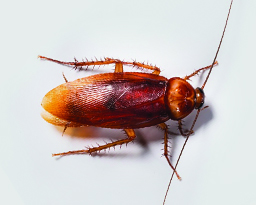FIND YOUR LOCAL
ARROW SERVICE CENTER
Periplaneta americana (L.)
The American cockroach is the largest of all house-infesting cockroaches in North America. Contrary to its name, the American cockroach was introduced to the United States from Africa as early as 1625.

| Color | Reddish brown, with a yellowish figure 8 pattern on the back of the head |
| Legs | 6 |
| Shape | Oval |
| Size | 2" |
| Antennae | True |
Measuring up to two inches in length, adult American cockroaches are reddish-brown or mahogany-colored, while cockroach nymphs resemble adults, but are wingless and gray-brown in color. Though American cockroaches have wings, they rarely fly unless temperatures exceed 85 degrees.
American cockroaches are capable of squeezing into extremely tight spaces, and are one of the fastest-running insects, with record speeds of 3.4 miles per hour, which would be comparable to a human running 210mph.
Roaches are usually looking for 3 main things if they enter your home: food, water, and shelter.
Food: Cockroaches aren’t picky, and will feast on food scraps, grease, pet food, and almost anything else edible. They have even been known to eat leather, book bindings, hair, clothing, and other roaches.
Water: American cockroaches are typically found in warm, moist environments, making kitchens, basements, and sewers great homes for these bugs. Leaking pipes, wet towels, and water left out for pets all have the potential to attract roaches.
Shelter: Clutter in and around your home can provide hiding places for roaches. Storage areas like garages, pantries, and basements provide the necessary environment for roaches to thrive.
Because roaches spend much of their time living in bathrooms, drains, and dumpsters, they are known to spread at least 33 kinds of bacteria, six kinds of parasitic worms, and at least seven other kinds of human pathogens. They can pick up germs on the spines of their legs and bodies as they crawl through decaying matter or sewage and then carry these onto food surfaces.
Recent medical studies have shown that cockroach allergens cause lots of allergic reactions in inner-city children. They were even shown to cause asthma in children. These allergens build up in deposits of droppings, secretions, cast skins, and dead roaches.
Of lesser concern is a bite from the American cockroach, although it is possible bites usually only happen in extreme infestation circumstances when food is scarce. A bite typically causes slight irritation with no lasting effects.
Early signs of a cockroach infestation may include strange smells, smears or droppings in or around kitchen appliances, new allergy symptoms, and one to two cockroaches scurrying around, usually at night.
Indications that you may have a larger infestation include stronger pungent, oily odor in storage areas, brown leathery egg casings behind or around furniture, damage and chewing marks to food and packaging, and seeing roaches during the day. For every roach you do see in your home, there are likely many more hiding.
To learn more about what cockroaches smell like, read our blog post on common pest smells.
Keep Clean: Regularly clean kitchens and dining areas, wiping down surfaces to remove crumbs and spills. Wash dishes promptly.
Seal Cracks and Crevices: Inspect your home for gaps around windows, doors, pipes, and other entry points. Seal them with caulk or weather stripping.
Store Food Properly: Keep food in airtight containers and avoid leaving pet food out overnight.
Eliminate Moisture: Fix leaky pipes and faucets, and use a dehumidifier in damp areas to reduce humidity.
Declutter: Minimize clutter, especially in storage areas, to reduce hiding spots for cockroaches.
Regularly Dispose of Garbage: Use tightly sealed trash cans and dispose of garbage regularly.
Maintain Outdoor Areas: Keep outdoor spaces clean and well-maintained. Trim shrubs and remove debris to prevent cockroaches from nesting nearby.
First, identify the problem, locate areas of activity and signs of the infestation.
Next set traps and baits:
Boric Acid: Sprinkle boric acid in areas where you see cockroach activity. It is toxic to them but safe for pets and humans if used properly.
Cockroach Baits: Use commercial baits that contain insecticides to attract and kill cockroaches.
Sticky Traps: Place sticky traps in areas where you've noticed activity to monitor and reduce their numbers. (Large roaches may not get caught in sticky traps)
Insecticidal sprays specifically designed for roaches also work well but always ensure you closely follow the instructions given by the manufacturer.
American roaches can be difficult to completely exterminate, and in many cases professional pest control is the best method to quickly eliminate the issue.
For a complete cockroach treatment plan, contact the Arrow Exterminators team using the form below or on our contact page.
After you submit the information below, a trained professional in your area will get in touch within 1-2 business days to set up a date & time that is convenient for you.